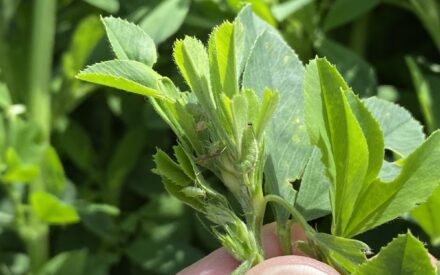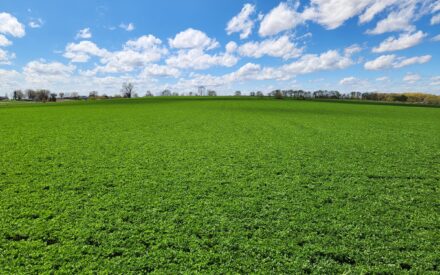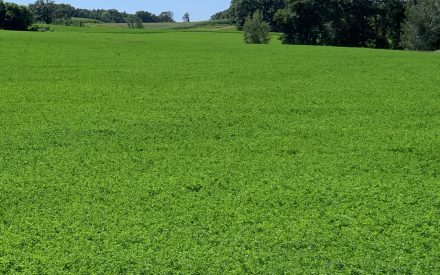Winter Injury occurs someplace in Wisconsin every year. Being able to diagnose and manage winter damaged stands may help prolong stand life and increase production. Below is a brief discussion on diagnosing and managing winter damaged alfalfa.
Diagnosing Winter Injury
Slow Green Up
One of the most evident results of winter injury is that stands are slow to green up. If other fields in the area are starting to grow and yours are still brown, it is time to check those stands for injury.
Asymmetrical Growth
Buds for spring growth are formed during the previous fall. If parts of an alfalfa root are killed and others are not, only the living portion of the crown will give rise to new shoots resulting in a crown with shoots on only one side or asymmetrical growth.
Uneven Growth
During winter, some buds on a plant crown may be killed and others may not. The uninjured buds will start growth early while the injured buds must be replaced by new buds formed in spring. This will result in shoots of different height on the same plant, with the shoots from buds formed in spring several inches shorter than the shoots arising from fall buds.
Root Problems
Probably the best way to diagnose winter injury is by digging up plants and examining roots. Healthy roots should be firm and white in color with little evidence of root rot, Winter injured roots have a gray, water soaked appearance and/or a brown discoloration due to roots rots. If the root is soft and water can be easily squeezed from the root it is most likely winter killed. If the root is firm but showing signs of rot it may still produce, depending on the extent of injury. If over 50% of the root is damaged, the plant will most likely die that year. If less than 50% is injured the plant will likely survive for 1 or maybe 2 years depending on management and subsequent winter. Table 1 below may be helpful in determining the likelihood for survival into the next season. See UW Ext. Pub. 3620 for more details on evaluating root health.

Managing Winter Injured Stands
Winter injured stands required different management than healthy stands if they are to stay in production for 1 or more seasons. If winter injury is evident consider the follow:
- Determine yield potential
- Potential yield of an alfalfa stand may be estimated by determining the number of stems in a square foot area. Once stem number is determined use the following formula to calculate yield potential of that stand:
- Yield (tons/acre) = (Stems/ft2 x 0.1) + 0.38
- For example, an alfalfa stand with 50 stems/ft2 would have a yield potential of 5.38. Remember, this is potential yield. Soil factors, nutrient deficiency, insects, diseases and many other things may affect the actual yield.
Use the table below, in conjunction with Table 1 above to aid in deciding whether to keep an existing, winter injured stand.

Allow plants to mature longer before cutting.
Allowing plants to mature to early, mid or even full bloom will help the plants restore needed carbohydrates for subsequent production. How long and during which cutting depends on the extent of winter injury. For severely injured stands, allow plants to go to nearly full bloom in first cut and to early flower in subsequent cuttings. This will give these stands the best chance at survival. Stands with less injury could be harvested somewhat earlier depending on the extent of the injury. Stands with only mild injury could be allowed to go to 10 to 25% bloom at some time during the season. It may be best to choose second or third cutting with these stands as first crop is usually or largest.
Increase cutting height.
This is particularly important when allowing plants to flower before cutting. Now, new shoots may be developing at the base of the plants. It is important to not remove these shoots as it will further weaken the plant to have to produced new ones.
Fertilize
It is particularly important that winter injured stands have adequate fertility. Soil test and apply needed fertilizer prior to first cutting if possible.
Control Weeds
Herbicide applications to control weed competition will help the stand by eliminating weeds which compete for moisture, light and nutrients.
No Late Cutting
Do not cut winter injured stands after Sept 1 to allow for the buildup of food reserves prior to winter.

 ▶ Forage Insect Pest Update
▶ Forage Insect Pest Update ▶ Determining the Value of Standing Forage
▶ Determining the Value of Standing Forage First crop insect scouting in alfalfa
First crop insect scouting in alfalfa


